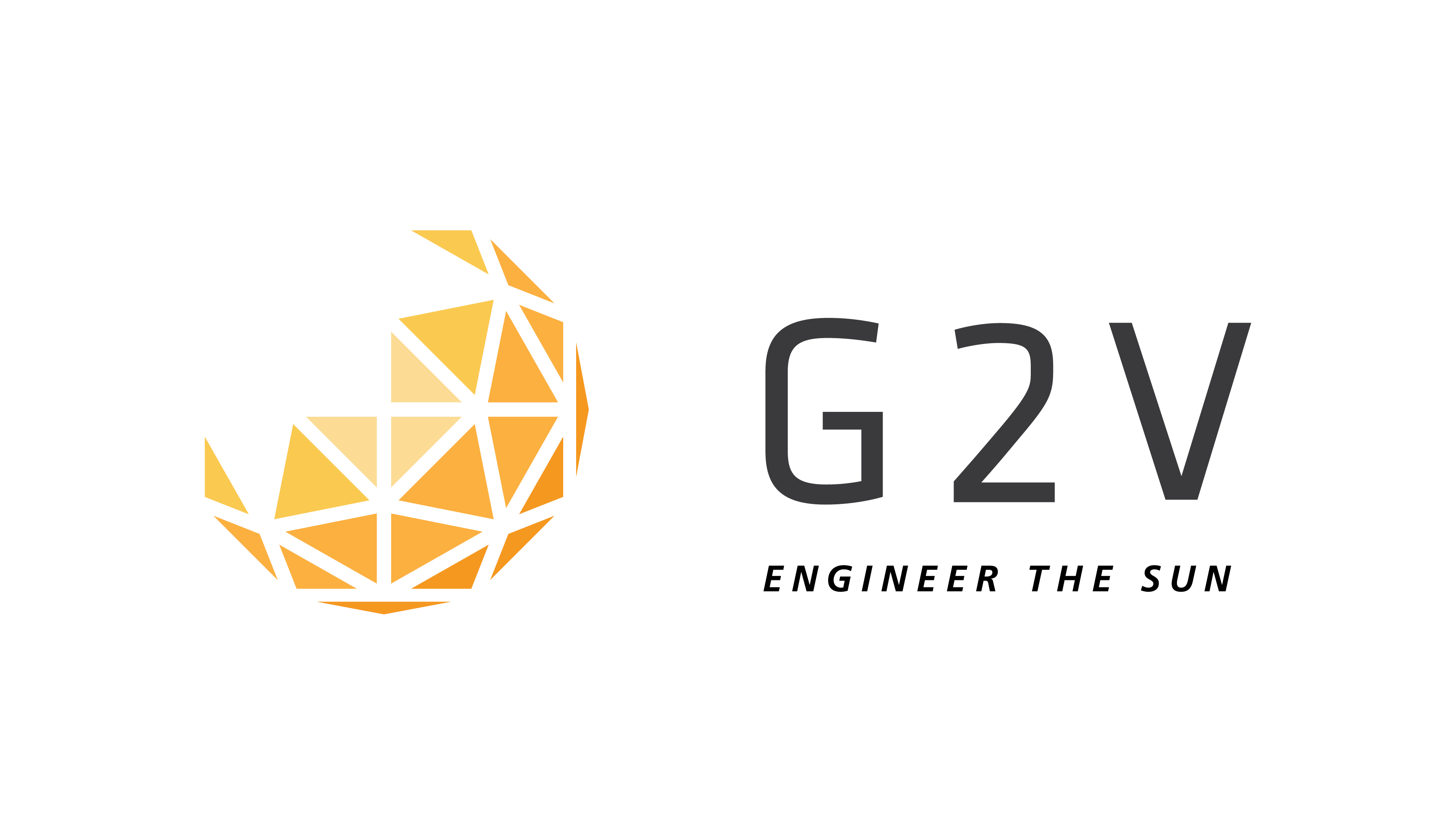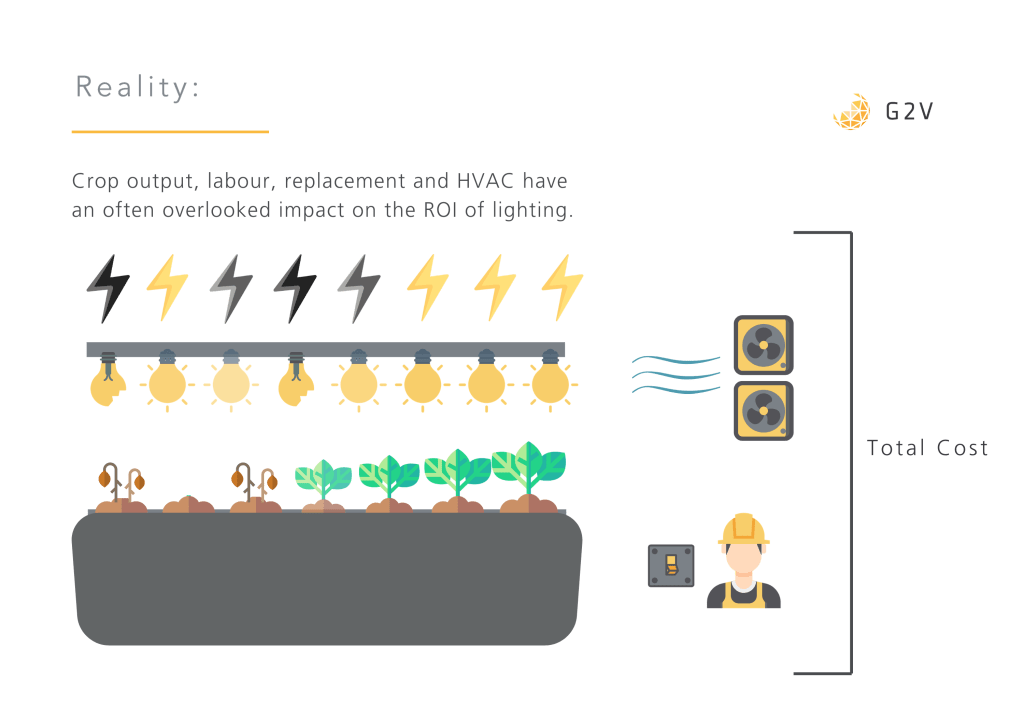Looking to install or upgrade your supplemental lights? Here’s a step-by-step guide to help determine what’s best for your needs.
Lighting is one of the most expensive and important decisions in controlled environment agriculture (CEA), whether in a greenhouse, indoor farm, or vertical farm. Lighting technology continues to evolve rapidly, however, producing an overwhelming number of options. How then is a grower to choose the right light? This article provides an answer.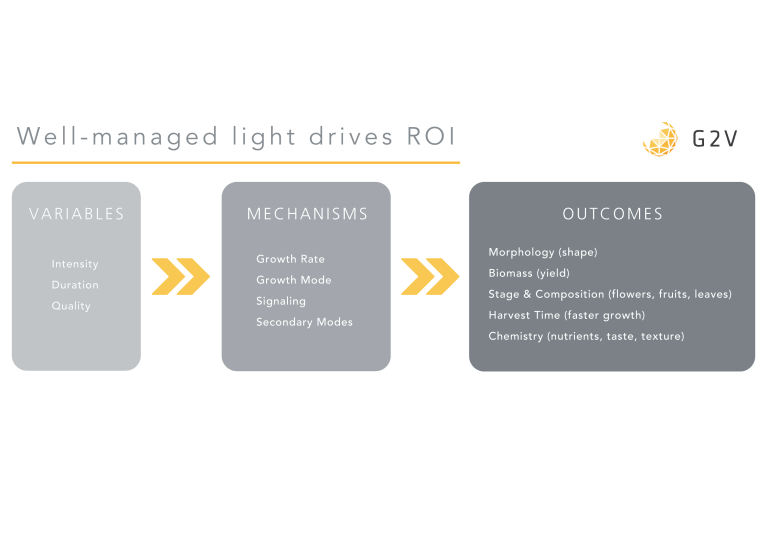
Important terms to know
Here are some important grow light terms:
PAR:
Photosynthetically Active Radiation, the light spectrum plants use for photosynthesis and development, historically ranging from 400 nm to 700 nm.
PPFD:
Photosynthetic Photon Flux Density, a measure of photosynthetically active photons shining on an area in a second.
Since billions of photons are usually involved, we count them in bunches called “moles” (1 mol = 6.02×1023 photons) or “micromoles” (1 μmol = 6.02×1017 photons).
Units are usually in micromoles of photons per square meter per second (μmol/m2s).
PPFD varies with distance and geometry.
Each crop will have a minimum and maximum PPFD that it can tolerate, and this will also depend on lighting duration.
DLI:
Daily Light Integral, how much light a plant receives in one day.
This is calculated by adding up the PPFD received by the plant within 24 hours. Units are moles per square meter per day (mol/m2d).
For example, 500 PPFD on a plant for 24 hours yields a DLI of 500 μmol/m2s x 86,400 s/day ÷ 1,000,000 μmol/mol = 43.2 mol/m2d.
A plant’s needs will sometimes be reported as DLI rather than PPFD.
How to select the right light?
In the best cases, the right grow lights can optimize output, temper operating costs and keep pace with an evolving market.
Define operational goals
Do you want to maximize yield, quality or flexibility between crops?
Do you want to minimize investment or maximize ROI?
With the sheer number of lighting products on the market, defining your operational goals helps you first narrow down the available technology to the candidates that best fit your needs.
Yield and quality may require continuous optimization over time, and knowing your operational goals will inform which technical specifications to focus on.
Knowing your goals, you’ll be able to ensure that your grow light solution not only meets your initial needs, but is also flexible enough to continuously optimize through the parameters most important to you.
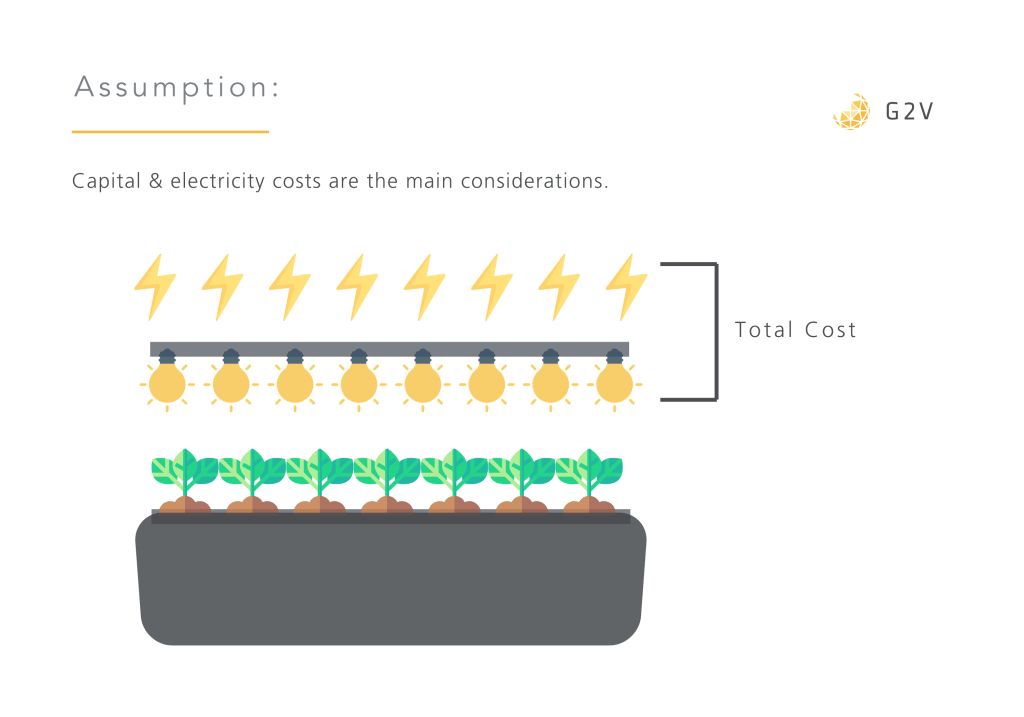
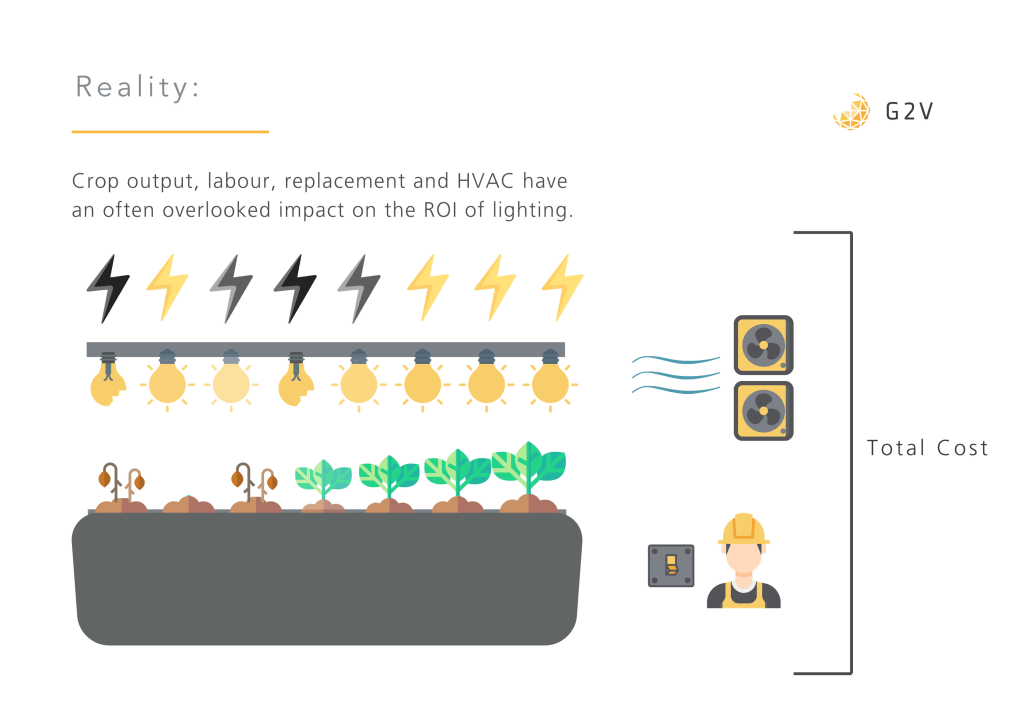
Determine Target Lighting Requirements
Lighting can be a five- to 10-year capital investment, so plan for the future. For example, if you know you’re starting with leafy greens but plan to incorporate vine crops within two years, consider building your system to accommodate the crops with higher lighting demands.
You can then determine your lighting targets from the following parameters:
Intensity (PPFD, DLI):
Which of your crops requires the highest PPFD or the greatest DLI?
Specify your system to meet the needs of your most demanding crops, present or future.
To find the recommended PPFD or DLI of your crop, look for verified agricultural resources and handbooks, such as “Measuring Daily Light Integral in a Greenhouse” from Purdue Extension.
Spectrum:
What distribution of wavelengths do you need?
Fixed output, broad-spectrum lights are generally acceptable for producing high quality plant growth across a range of crops, but more advanced lighting systems can adjust the spectrum for specific needs.
For example, if you get the most commercial value from budding or flowering products, you might focus on systems that enable you to adjust the ratio of red to far-red light during different phases of growth.
Too much far red light, however, might falsely signal to the plant that it’s being shaded, triggering shade-avoidance mechanisms such as elongation or altered flowering time that are contrary to your crop goals. The right ratio of red to far red light, in contrast, can let you trigger flowering when you want it.
If optimizing photobiology through the growth cycle can improve commercial value, adjustable spectrum lighting might be a feature to consider.
Uniformity:
Often overlooked is whether your light is uniform. Is one plant going to be saturated, while others are light-starved?
While you can ensure your plants are lit by properly placing them under the fixtures, the fixture design determines how much flexibility you have for the placement of crops, while still achieving a certain uniformity in illumination.
Look at the manufacturer’s uniformity and illumination specifications to know the distance and acceptable angles for achieving a certain PPFD.
Uniformity is achieved by the combination of a grow light’s specifications and the overall room design, so some lights won’t work with your expected grow environment.
Coupling:
This is another often – overlooked factor in grow lights – how much of the emitted light actually reaches plants (reported as a percentage) – that relies on both light specs and layout design.
Many layouts leave 30 per cent of light spilling into aisles and not contributing to plant growth.
This is wasted capital and adds to your operating expense.
How well the light couples to your plants is determined by the plant’s canopy shape, as well as the light fixture’s angle of emission and distance.
If you’re growing in a single layer of connected tables, your coupling will be high (95 per cent) with wide-emission lights. But if you’re growing on racks where there are typically walkways in-between, the height of the rack lighting will dramatically impact how much light is lost.
If your rack lighting is quite high compared to your plant canopy, wide-emission lights can result in a lot of wasted electricity in lighting up your walkways.
If you have many levels of rack lighting that are mounted close to the plant canopy, then the loss from spilled light is less.
Look for specifications of angular emission, as well as whether or not the lights are lensed, and compare them to your intended layout. See how much of your lighting investment is going to contribute to plant growth.
If optimizing photobiology through the growth cycle can improve commercial value, adjustable spectrum lighting might be a feature to consider.
Determine the total area you need to cover
What’s your total area for growing crops?
How large is your expected leaf canopy?
Are you willing to accept lower light quality around the perimeter?
In general, don’t include the area of walkways and benches in your estimation, but it will depend on the shape of the room.
When you’re growing in racks, only the racking counts, but when it’s a large single-layer canopy room, often the walkways are illuminated (unintentionally) by the lights, and might have to be included in the area. One good way to avoid this is by using rolling tables.
In general, you want to cover as much of the growing area as possible compared to the perimeter, because correcting for non-uniformity gets expensive around the perimeter of any grow operation.
It’s also worth considering options such as accepting poor light uniformity around the edges of the production area, and compensating by crop rotation.
Some growers, for example, will deliberately choose a light that illuminates a smaller area than their plant’s canopy, then rotate the positions of the plants throughout the year. This can save costs if the lights are more expensive than the labour required to regularly move crops.
The total area you want to illuminate, as well as the quality of illumination you want in each area, will help drive the number of lights you need and potentially the type of lights based on total cost.
Find and design with different light options
Armed with your requirements, your search for lighting can now be more focused.
Consider a few different technologies so you can assess the widest range of offerings possible.
For example, while high-pressure sodium (HPS) and ceramic metal halide (CMH) lamps have been very common in horticulture, LED technology now offers significant competitive advantages including energy efficiency, better lifetimes, and a multitude of adjustable settings for different lighting recipes.
Once you’ve narrowed it down to a few types of grow lights based on their specifications, use their parameters to design detailed layouts and light studies to verify your assumptions about fixture number, uniformity, and coupling.
Make sure you understand the costs and features offered by each lighting technology option.
Estimate benefits
All too often, growers focus on a single aspect of lighting – a cost to be minimized.
This can become a missed opportunity to maximize value for their operation.
Photons are the primary driver of photosynthesis, and therefore outcomes of cultivation.
Lighting should be seen as an investment in infrastructure to maximize operational output.
Most commercial farms are driven by crop revenue per year per unit area, which is calculated using the crop’s sale price, mass produced per unit area, and number of harvests in a year.
All this is heavily driven by lighting quality. Better quality light can increase the sale price, improve yields or shorten harvest times.
Light intensity, spectrum, uniformity, and above all, intelligent light management, can all drive cultivation value.
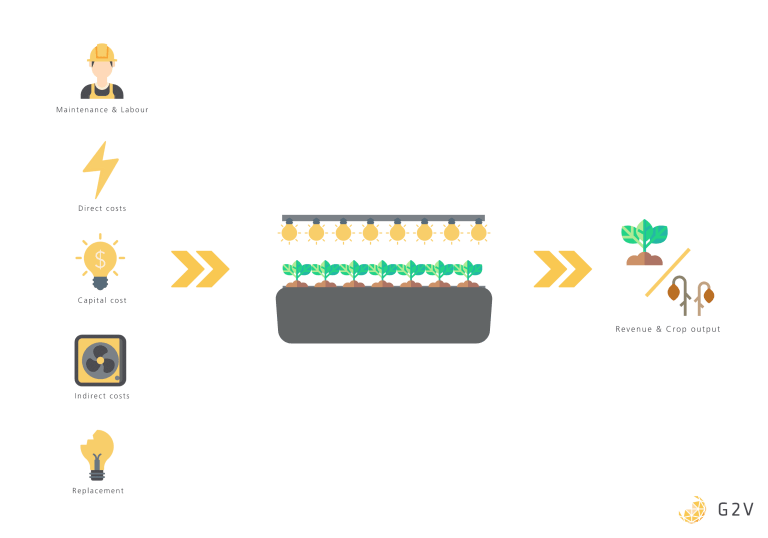
Intelligent light management is the use of data to determine the spectral intensity and duration of illumination at any point in a plant’s lifecycle.
In small facilities and early stages of growth, light management can be achieved through human monitoring and manual control by an expert.
In large commercial facilities, however, light management is best achieved through real-time monitoring and intelligent light management platforms.
Such automated platforms are becoming increasingly available commercially. The quantifiable benefits of high quality lighting, such as annual crop revenue per unit area, however, are difficult to estimate.
For growers new to a particular crop, talk to grower associations and look up federal agricultural yield reports for how much to expect out of a crop. From this, you can estimate the rough benefits of crop growth, but you won’t necessarily be able to compare different options.
To compare different lighting options or conditions, the best approach is to pilot and validate.
Don’t build an entire facility based on theoretical yields!
Instead, spend a smaller amount and run trials to accurately assess, for example, whether a 30 per cent higher PPFD pays for itself in yield.
Pilot studies can be time-consuming but essential for exploring the benefits of particular grow lights. Successful pilot studies rely on working with trusted partners throughout the optimization process.
Crop revenue per year per unit area, is calculated using the crop’s sale price, mass produced per unit area, and number of harvests in a year.
Estimate initial purchase cost
The number of lights purchased comes down to the total illumination area needed, the illumination area of one light, and the price of one light.
This is the obvious cost that most growers will consider, along with the electrical costs of running the lights.
Estimate other, less obvious costs
Lights are intimately tied to complex production equipment required for CEA.
While the initial purchase cost is important, in reality, any horticultural operation takes on:
- Capital costs (cost of lights, cost of integration)
- Direct electricity costs (electrical power for the lights)
- Indirect operating costs (HVAC, ongoing labour costs, management overhead)
- Degradation, replacement, and end-of life costs (bulb or fixture replacements)
Take, for example, grow lights with low up-front costs but excess heat generation.
Although the initial capital expense might be low, costs of the HVAC system might increase to manage a higher heat load in the summer.
Cheaper bulbs might also be prone to failure, incurring ongoing maintenance expenses.
Least obvious of all is the cost of degradation; all lights degrade over time resulting in reduced light yield and revenue.
Labour can be costly too. While a lower cost option might require personnel to go in and manually turn sections of lights on or off, a more expensive lighting solution might be automated.
Make sure you’ve looked at the broader picture and considered any hidden operational costs.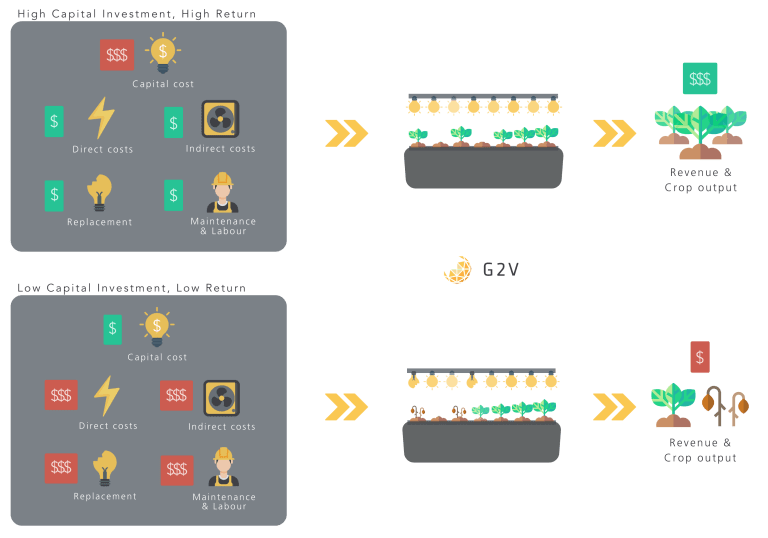
Least obvious of all is the cost of degradation; all lights degrade over time resulting in reduced light yield and revenue.
Calculate ROI and payback period
You now have all you need to calculate the return on investment (ROI) and the payback period.
Generally speaking, the ROI is calculated by dividing the sum of the benefits by the sum of all costs (including all indirect and potential hidden costs) over a time period of interest.
For a very simplified example, take two different lighting systems:
- System A has a capital cost of $75k, annual operating cost of $10k, and is estimated to produce $100k annually.
- In contrast, System B has a capital cost of $100k, annual operating cost of $15k, but is estimated to produce $125k annually.
The second system essentially amounts to a 33 per cent higher upfront cost, 50 per cent higher operating cost, and 25 per cent higher yield capabilities.
At face value, the lower-cost lighting system may appear to provide more value in the short term. However, the longer term benefit of 25 per cent more yield can have a major impact on the return from the $25k difference in investment between the two systems.
You can calculate the simple ROI on the marginal difference between the two investments after five years of the additional $25k capital investment as:
[(Additional revenue for 5 years) – (Additional cost for 5 years) – (Additional capital investment)]/(Additional capital investment).
The additional revenue each year is $25k and the additional cost per year is $5k, so the simple ROI is [(5 x $25k) – (5 x $5k) – $25k]/$25k = 3 (or 300% ROI!).
The payback period is calculated as (Investment amount)/(Estimated additional cash flow), or in this case (Additional capital investment)/ (Additional annual revenue – Additional annual cost) => ($25k)/($25k – $5k) = 1.25 years.
Note that these are highly simplified examples which don’t include some of the more important aspects such as light degradation and yield variation over time.
However, these examples do illustrate some of the key principles we’ve described throughout the article, and how the best lighting solution is not necessarily the most obvious one.
Be sure to work with financial experts to develop a proper financial model including the time value of money and cost of capital in order to capture nuances and maximize returns on your valuable lighting investment.
The payback period is calculated as (Investment amount)/(Estimated additional cash flow), or in this case (Additional capital investment)/ (Additional annual revenue – Additional annual cost)
Final Tips
- Cheap lighting isn’t usually cheap in the long run.
- There is no such thing as a “perfect spectrum.” Different crop types, growth stages/methods and goals have different optima.
- Flexibility is advantageous over the long term.
- The hidden costs of light degradation are often overlooked.
- Ongoing support wins. Grow lights are complex production equipment.
This article introduces grow-light profitability, but an expert can help you learn more.
